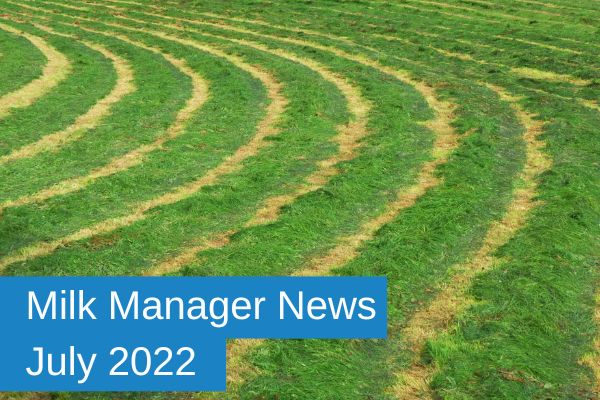Milk Manager News July 2022 – What are the Benefits of Wholecrop Silages?
1 July 2022With increasing costs, it is important to consider all feed options that could be grown on farm to reduce the cost of purchased feeds. A cost-effective and high-quality forage which can be grown on farm is wholecrop silage. Cereals are a versatile crop that grow well in certain areas of Scotland and barley, wheat and oats can be used to make wholecrop silages. If first cut silage yield is not as expected and it is thought that winter forage supplies could be tight, then wholecrop cereal is a great way to boost forage stocks.
Making wholecrop silage has several advantages including it being harvested directly rather than needing mowing and then picked up. These silages do not require wilting so the crop can go into the pit on the same day that it is harvested. Compared to grass silage, wholecrop silages require a third of fertiliser N per hectare, which in a year where fertiliser prices have risen significantly, is a way of reducing the cost of producing feed for dairy cows. Wholecrop silages are easy to preserve but use of an additive is recommended for high dry matter crops which may not ferment as easily and will ensure reduced risk of heating at feedout. They also tend to have lower dry matter (DM) losses in the clamp compared to grass silages.
Harvesting the crop at the correct growth stage is critical to ensure that the energy levels are between 10 and 11 MJ/kg DM, and if the crop matures to a late stage, the energy content of the wholecrop will drop and it is unlikely to exceed 10.5 MJ/kg DM. Typically, whole crop barley, wheat and oat silages are harvested at a DM content of 35 – 45%, when the grains are at the soft cheese stage. When crops are harvested at this stage, the silage produced tends to have an energy level similar to average grass silage, however the starch content will be higher and crude protein levels will be lower. At this stage, the grains from the silage are efficiently digested by the rumen microbes in the cow.
Wholecrop silages are a good source of home-grown starch which can reduce the reliance on purchased cereals. Typically, the energy levels are between 10 and 11MJ/kg DM, and protein levels are lower than grass silage at 9 to 11% as seen in the table below. Wholecrop silages contain slow fermenting starch compared to starch from harvested cereals and so can contribute towards a more stable rumen pH, maximising rumen function.
Average nutrient values of grass and wholecrop silages
| Grass silage | Wholecrop wheat | Wholecrop barley | |
| Dry matter (%) | 24 | 40 | 30 |
| Crude protein (%) | 13 | 9.5 | 9.5 |
| Starch (%) | – | 20 | 15 |
| ME (MJ/kg DM) | 10.6 | 10.5 | 10.0 |
Feeding wholecrop silages to dairy cows can increase dry matter intakes and fibre levels and compliments wetter silages well to improve ration presentation. Wholecrop silages are recommended at an inclusion rate of up to 40% of the total forage DM. The addition of wholecrop silages to the ration can help create a healthy rumen environment which is important for the digestion of the overall ration.
As wholecrop is lower in protein than grass silage, you will need to ensure the protein requirements of the cows are being met through concentrate supplementation and you may need to increase the quantity of concentrate dependent on milk yields. Wholecrop silages can be fed to dry cows however you will need to consider the protein deficit so these cows may need concentrate added to their diets. If you are using wholecrop silage in the diet for the first time, it is important to speak to your nutritionist to ensure the cow’s energy and protein requirements are being met by the new ration.
cara.campbell@sac.co.uk; 01586 552502
Sign up to the FAS newsletter
Receive updates on news, events and publications from Scotland’s Farm Advisory Service

